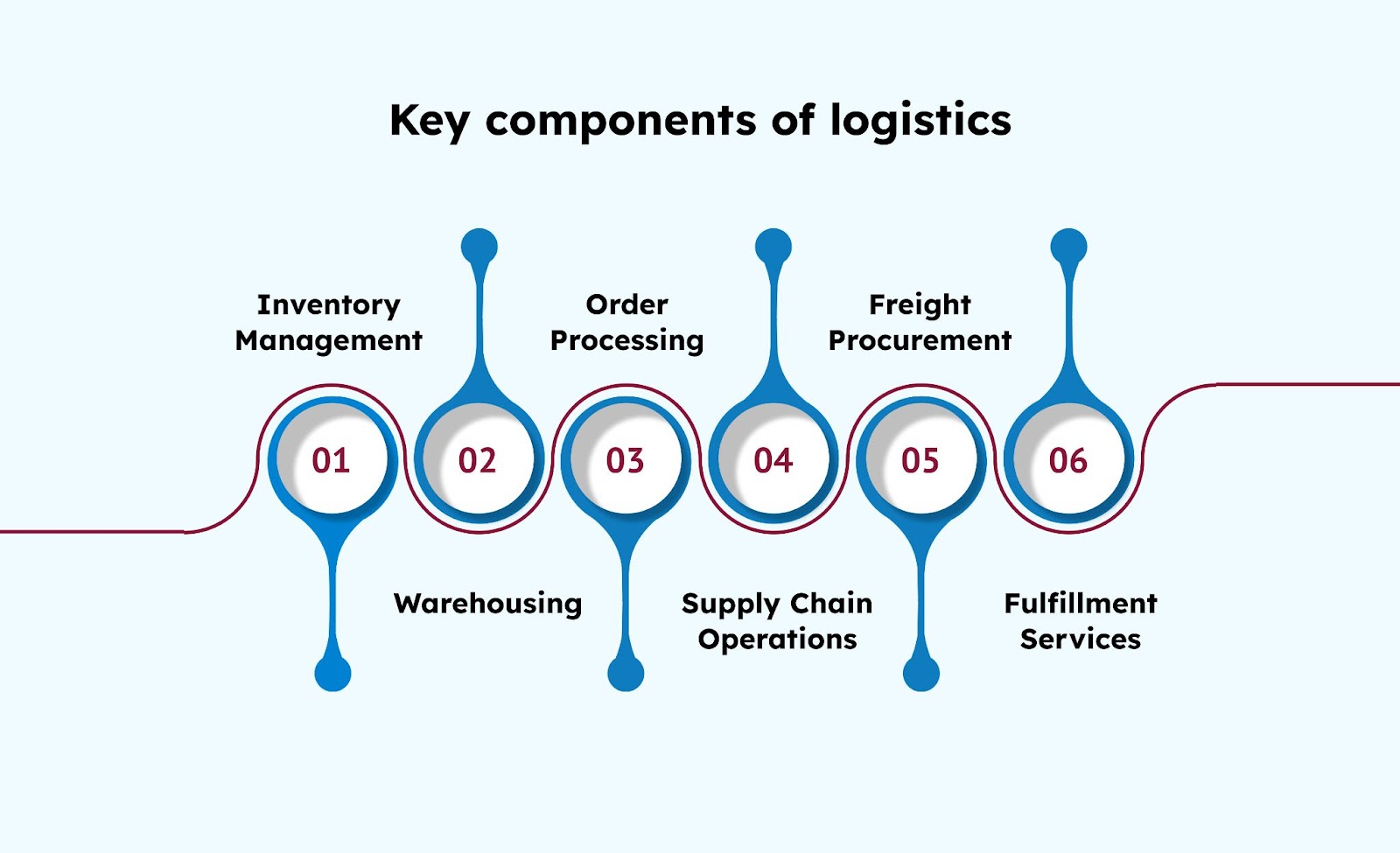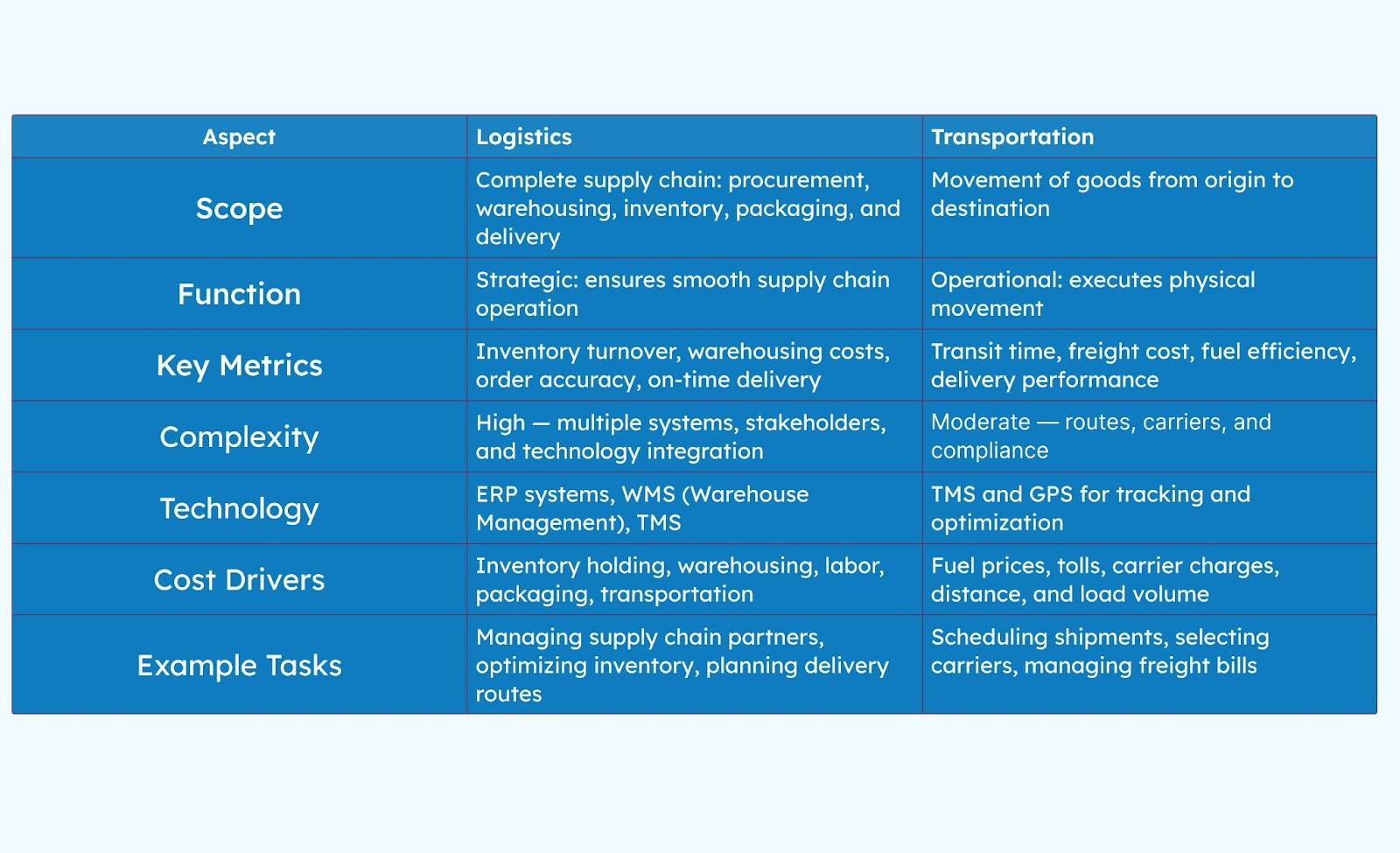Running a business, especially in e-commerce, means dealing with a lot of moving parts. One of the biggest challenges is making sure products move smoothly from storage to the customer. In fact, 60% of businesses report struggling with supply chain visibility and managing inventory. These issues can lead to delays, additional costs, and a negative customer experience.
Knowing the difference between logistics vs transportation is key to solving these problems. Both are important in getting products to their destinations, but they focus on different aspects of the process. Let’s break down what each one does and how they work together to make your supply chain run more smoothly.
What Is Logistics?
Logistics is the broader field that focuses on the entire process of managing the flow of goods from point A to point B. It involves everything from inventory management to warehousing, order fulfilment, and beyond. Logistics covers every step involved in ensuring products are delivered efficiently and on time.
Key components of logistics

Logistics is the behind-the-scenes process that ensures goods are available when and where they’re needed. To understand how logistics works, let’s take a look at its key components:
- Inventory Management: Keeping track of stock levels, avoiding overstock or shortages, and ensuring products are available when needed.
- Warehousing: Storing goods in strategically located facilities, ensuring products are easy to access and ship.
- Order Processing: The actions taken to package, label, and ship orders quickly and accurately.
- Supply Chain Operations: Coordination of all the processes that come together to deliver goods in the most efficient way possible.
- Freight Procurement: Managing the selection and negotiation of transport providers to secure the best rates and services for moving goods.
- Fulfillment Services: Handling the complete process of order fulfillment, from receiving products to picking, packing, and shipping them to customers.
Logistics is the backbone of any supply chain, ensuring products are stored, tracked, and delivered efficiently. For example, imagine an online retailer handling thousands of orders daily. They rely on precise logistics to manage inventory, ensure products are stored in the right locations, and coordinate timely deliveries to customers, guaranteeing everything arrives on time, as promised.
What Is Transportation?
Transportation, on the other hand, is the physical movement of goods from one location to another. It's an essential part of the logistics chain, but focuses purely on how goods are moved. Whether by road, rail, air, or sea, transportation ensures that products reach their destinations.
Common modes of transportation
Different modes of transportation are suited to various needs, each offering benefits based on distance, urgency, and the type of goods being transported. Here's a quick look at the most common modes used in logistics:
- Road: Ideal for short distances, road transport offers flexibility and is cost-effective for local deliveries or nearby cities. Trucks and vans are commonly used for smaller shipments or regional transportation.
- Rail: Ideal for bulk shipments over long distances, rail transport is a reliable mode of transportation for industries such as agriculture and manufacturing. It's slower than road or air transport and depends on the availability of rail networks.
- Air: The fastest mode, air transport is best for high-value, perishable, or time-sensitive goods. Although more expensive, its speed makes it the top choice for urgent shipments in sectors such as electronics and pharmaceuticals.
- Sea: The most cost-effective option for large international shipments, sea transport handles bulk goods at lower costs. While slower than air, it’s ideal for global supply chains that deal with large quantities of products, such as machinery and raw materials.
While logistics focuses on managing goods, transportation ensures they reach their destination. Each mode is chosen based on factors like distance, urgency, cost, and the type of goods.
For example, an e-commerce retailer may use air transportation to quickly deliver a high-demand electronics product, ensuring fast and secure delivery to the customer.
The Key Differences Between Logistics and Transportation
Both logistics and transportation are essential components of supply chain management, but they serve different functions. Understanding these differences in logistics vs transportation is key to improving operations and ensuring efficiency throughout the entire supply chain. Here's a closer look at how they differ:

Logistics handles planning, while transportation moves the goods. Both play distinct but connected roles in the supply chain. Let's see how they work together.
How Logistics and Transportation Work Together?
Logistics and transportation are two sides of the same coin in supply chain management. While logistics focuses on planning and strategy, transportation is responsible for executing these plans by moving goods from one point to another. Without transportation, even the most efficient logistics plan would fall short in delivering products to customers.
WareOne's Role in Simplifying Logistics and Transportation
WareOne's digital platform connects SMEs with trusted 3PL partners to offer on-demand transportation and fulfilment services, making supply chain management easier and more flexible.
Here are the key features of WareOne:
- Flexible Storage Options: Pay only for the space you need, with terms that adapt to your changing inventory requirements.
- On-Demand Transport Services: Effortlessly manage deliveries and returns across Qatar and the UAE, ensuring no delays.
- Real-Time Tracking: Track your stock and shipments from start to finish with our intuitive platform.
- Dynamic Pricing: Enjoy transparent, flexible pricing that adjusts to your business's needs, helping you stay cost-effective.
- Customs & Compliance Support: We handle import documentation, ensuring seamless and hassle-free cross-border logistics.
With these services, WareOne makes logistics and transportation work in perfect harmony, offering businesses the flexibility and efficiency they need without the burden of long-term contracts.
How Technology Enhances Logistics and Transportation
Technology plays a vital role in enhancing both logistics and transportation. By integrating advanced systems, businesses can streamline operations, reduce costs, and enhance efficiency across the supply chain.
Technology in Logistics
For logistics, tools like real-time tracking and data analysis help businesses stay organised and ensure timely deliveries:
- Warehouse Management Systems (WMS): Optimize stock levels and order accuracy.
- Real-Time Tracking Tools: Platforms like Fleet Complete and Project44 offer visibility throughout the shipment journey.
- Data Analytics: Tools like Tableau and Power BI analyse trends for better decision-making.
Technology in Transportation
Transportation technologies enable faster and more cost-effective deliveries. Some important tools include the following:
- Transportation Management Systems (TMS): Systems like Oracle TMS and SAP help manage routes and carrier performance.
- Route Optimization Tools: Software like Route4Me and TruckRoute plan the most efficient delivery routes.
- Carrier Management Software: Platforms like Transporeon provide real-time visibility into shipments.
WareOne uses advanced technology to simplify logistics and transportation, offering real-time tracking, dynamic pricing, and AI-powered warehouse matching to help businesses save costs and optimize their supply chains.
Looking to improve your supply chain? Explore WareOne's flexible warehousing and transportation solutions today!
Conclusion
Understanding the roles and interdependence of logistics and transportation is essential for businesses to create a seamless and efficient supply chain. Both are vital for delivering goods on time, reducing costs, and providing the customer experience that today's market demands.
If you're looking to make your supply chain more efficient and cost-effective, WareOne has the tools you need. From flexible warehousing to seamless transportation solutions, we're here to help you simplify and optimize your logistics. Let's get started today!
FAQs
1. What is the difference between logistics and transportation?
Logistics involves managing the flow of goods, including inventory, warehousing, and order Fulfilment, while transportation focuses on the physical movement of goods from one location to another.
2. How do logistics and transportation work together?
Logistics provides the strategy and planning, while transportation executes the plans by moving goods and materials. Together, they ensure products are delivered efficiently and on time.
3. Why is technology important for logistics and transportation?
Technology helps streamline operations, improve visibility, reduce costs, and enhance efficiency. Tools such as real-time tracking, route optimization, and data analytics enhance decision-making and improve delivery times.
4. How can WareOne help with logistics and transportation?
WareOne simplifies logistics and transportation for SMEs by offering flexible warehousing, real-time tracking, dynamic pricing, and on-demand transportation services, helping businesses save costs and streamline their operations.
5. What are the key technologies used in logistics and transportation?
Key technologies include Warehouse Management Systems (WMS), Transportation Management Systems (TMS), route optimization tools, real-time tracking, and data analytics. These tools help businesses improve efficiency and decision-making in both logistics and transportation.
.jpg)